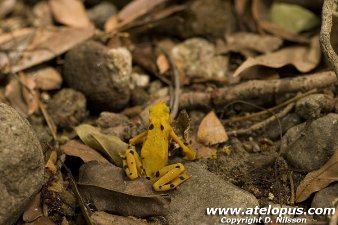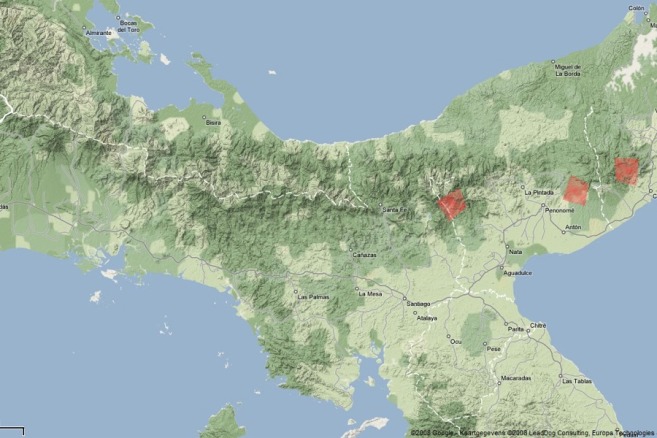Habitat
As I am sure you have already gathered, the Panamanian Golden Frog is native to the nation of Panama - what a surprise! Because of its critically endangered status as a species, most of the remaining population has been taken in by biologists to breed and re-establish the population. That being said, the habitat described below is its preferred habitat, in other words, the habitat that it was observed in before its population dwindled.
Courtesy of the Seneca Park Zoo Society.
Courtesy of www.atelopus.com.
Photo taken by
Heather Kuepper.
Photo taken by Dennis Nilsson.
With regards to its general habitat, Atelopus zeteki can
be found in western/central Panama in the Central Cordilleran
cloud forests and rainforests. It prefers one of two
environment types: wet forest areas near streams or dry forest areas
near streams. These two environments range
 in
altitude from 335 meters above sea level to 1315 meters above sea
level which are the preferred altitudes for the organism.
Interestingly enough, the frogs found in the wet forest areas near
streams are larger in size compared to the frogs found in the dry
forest areas near streams. In the wet forest areas, the
organism can be found up to 3 meters off the ground. They
enjoy resting near waterfalls on boulders covered in moss as well as
along the banks of the nearby streams. In contrast, the frogs
found in the dry forest areas can be seen climbing to a maximum of
approximately 1.5 meters off the ground but spend most of their time
on the forest floor.
in
altitude from 335 meters above sea level to 1315 meters above sea
level which are the preferred altitudes for the organism.
Interestingly enough, the frogs found in the wet forest areas near
streams are larger in size compared to the frogs found in the dry
forest areas near streams. In the wet forest areas, the
organism can be found up to 3 meters off the ground. They
enjoy resting near waterfalls on boulders covered in moss as well as
along the banks of the nearby streams. In contrast, the frogs
found in the dry forest areas can be seen climbing to a maximum of
approximately 1.5 meters off the ground but spend most of their time
on the forest floor.
The male and female population of the frogs differ in habitat on a seasonal basis. The females are known to move away from streams and farther into the forests anytime from February to March marking the end of the dry season and the beginning of the rainy season. They then return to the streams anytime from November to January marking the end of the rainy season and the beginning of the dry season. The males, however, remain along the streams all year round with the goal of establishing their own territory from fellow frogs and preparing for the return of the female frogs.
When the Atelopus zeteki population was not in danger of extinction, the population density was much larger in the dry forest environment as opposed to the wet forest environment. Its original distribution can be seen in the map below with the two regions highlighted furthest to the right: El Valle de Antón and Cerro Campaña.
Note: The region highlighted to the far left on the map was originally thought to be an Atelopus zeteki population, but through DNA testing it was found to be Atelopus varius instead.
Interested in another organism that calls Panama one of its homes? Check out Cinchona pubescens, otherwise known as the Fever Tree.
Note: Unless labeled, all images used under public permission.
To continue on to the Panamanian Golden Frog's adaptations, click here.
Are you lost? Go back HOME.



